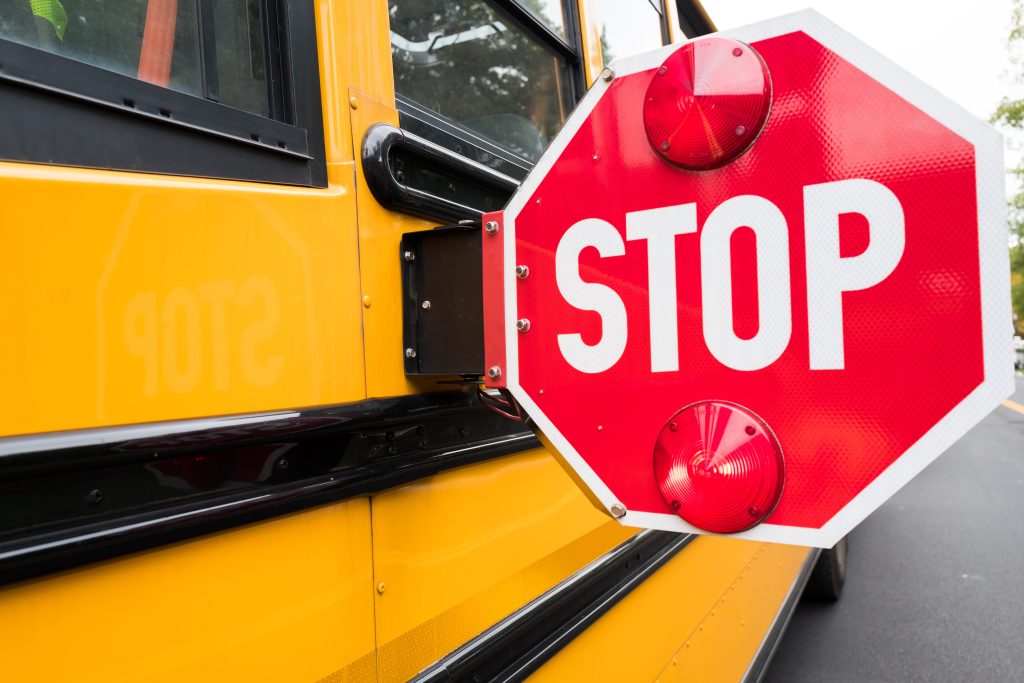
We’ve all been there. We see the school bus slowing down, yellow lights flashing, and we panic. Do I stop? Do I keep going? Am I even supposed to stop from this direction?
No matter how long you’ve been driving, chances are you’ve been in a position where you questioned your own knowledge about school bus safety. We all know red means stop, but what do you do when the yellow lights are flashing? What if you’re on the other side of the road?
While riding a school bus is the safest mode of transportation for school children, let’s get the facts straight on when it is – and isn’t – OK to pass a school bus, when you should begin to slow down and how far away from the bus you need to stop.
Together we can ensure all Maryland school children make it on and off the bus safely each day.
Yellow Flashing Lights are Activated
If a school bus has activated its flashing yellow lights, this is your signal that the bus driver is preparing to stop and pick up passengers. You should slow down and prepare to stop. If you are already alongside the bus when this occurs, continue driving — with increased caution, as children may enter the roadway before the bus has come to a complete stop.
Red Flashing Lights are Activated 
Once the bus driver has activated the flashing red lights and stop signal, all vehicles sharing the roadway with the school bus must stop a minimum of 20 feet from the bus, regardless of the direction of travel if either of these conditions are met:
- You are traveling in the same direction as the school bus. This is true whether the road has one lane, multiple lanes or a central turning lane.
- You are traveling in the opposite direction and the road does not have a dirt, grass or barrier median. In other words, if there is no physical median, you must stop even if the bus is on the other side of the road.*
- You are making a left-turn onto a street and you notice a school bus stopped in the opposite direction, and must make a decision whether to stop in oncoming traffic or pass the bus. In this case, you must still stop and not pass the stopped school bus.
* In Maryland, if the roadway is separated by a physical median – such as dirt, grass, or barrier – you are not required to stop, but you should proceed with caution. (Note: In some states, you must stop for school buses even on a divided highway.)

What if I Don’t See Children Waiting to Cross or I’m Running Late?
The law is clear on stopping for school buses. Drivers do not get to make judgment calls on whether it’s safe to pass a stopped bus. Regardless of whether the driver is running late or feels inconvenienced or stuck behind a bus making multiple stops, you must stop.
It’s impossible to know whether there are children about to dart out to make a run for the bus, or whether they’re simply standing out of your line of sight. If you’re a driver and you often find yourself behind a school bus, it would be best to adjust your schedule to leave a few minutes earlier each day.
Children do not always know or understand the rules of the road. Their behavior can be unpredictable, and they may enter the roadway unexpectedly. Drivers are expected to know traffic safety laws and obey them. Always remain alert while driving, not just for yourself, but for our most vulnerable road users.
School Bus Violations Can Be Expensive — and Deadly
The penalties for passing a stopped school bus are steep because the risk of doing so is potentially deadly for school children.
Many school buses across the state are now equipped with automated enforcement technology that captures vehicle and license plate information of drivers who commit a stop-arm violation. These infractions carry a penalty of $250 for each violation. Violators who are stopped by a police officer face a fine of up to $570 and three points on their driver’s license.
Think about it: legal penalties pale in comparison to the consequences of striking a child who is boarding or exiting a school bus. Criminal charges aside, the lifelong repercussions for the family and friends of the victim and the burden of living with that impact are difficult to even contemplate.
Give Children a Brake
Although school bus safety begins at an early age, the last thing on the minds of most school children is boarding and exiting the bus safely. In the morning, they are excited about seeing friends and telling their teacher their latest joke or funny story. On the ride home, their focus is on getting home to play or tell someone about their day.
It is incumbent upon drivers to remain alert, slow down and know the law when it comes to stopping for school buses. Ignorance and inconvenience are not valid excuses for stop-arm violations. Together, we can ensure that all school children make it to and from the bus safely.

